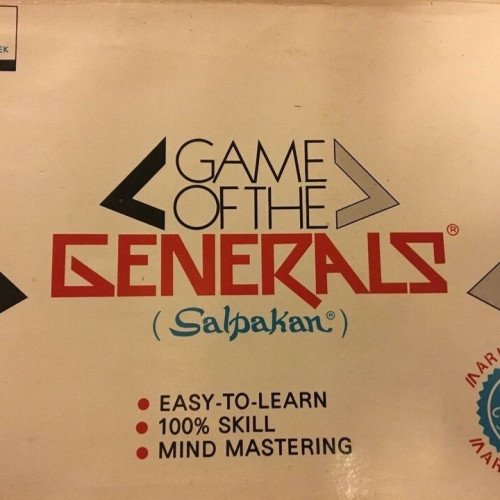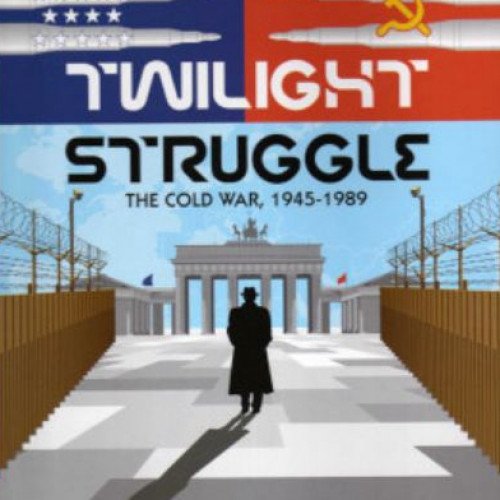GAME OF THE GENERALS VS TWILIGHT STRUGGLE

GAME OF THE GENERALS
The Game of the Generals, also called GG or GOG as it is most fondly called, or simply The Generals, is an educational war game invented in the Philippines by Sofronio H. Pasola Jr. in 1970. Its Filipino name is "Salpakan." It can be played within twenty to thirty minutes. It is designed for two players, each controlling an army, and a neutral arbiter (sometimes called a referee or an adjutant) to decide the results of "challenges" between opposing playing pieces, that like playing cards, have their identities hidden from the opponent. The game simulates armies at war trying to overpower, misinform, outflank, outmaneuver, and destroy each other. It optimizes the use of logic, memory, and spatial skills. It simulates the "fog of war" because the identities of the opposing pieces are hidden from each player and can only be guessed at by their location, movements, or from the results of challenges. The game allows only one side's plan to succeed, although a player may change plans during the course of the game. In addition, there are two different ways of winning the game (see below). Certain strategies and tactics, however, allow both sides the chance of securing a better idea of the other's plan as the game progresses. Players can also speak or gesture to their opponents during matches, hoping to create a false impression about the identity of their pieces or their overall strategy. This game was invented by Sofronio H. Pasola, Jr. with the inspiration of his son Ronnie Pasola. The Pasolas first tried the Game of the Generals on a chessboard. Even then, the pieces had no particular arrangement. There were no spies in the experimental game; but after Ronnie Pasola remembered the James Bond movies and Mata Hari, he added the Spies. Making the pieces hidden was the idea of the Pasolas after remembering card games. The Game of the Generals' public introduction was on February 28, 1973. After the game was made, it angered many Filipino chess players thinking that Pasola was trying to denigrate or supplant chess.
Statistics for this Xoptio

TWILIGHT STRUGGLE
Twilight Struggle: The Cold War, 1945–1989 is a board game for two players, published by GMT Games in 2005. Players are the United States and Soviet Union contesting each other's influence on the world map by using cards that correspond to historical events. The first game designed by Ananda Gupta and Jason Matthews, they intended it to be a quick-playing alternative to more complex card-driven wargames. It achieved critical acclaim for its well-integrated theme, accessibility and introduction of Eurogame elements. After being voted the number one game on BoardGameGeek from December 2010 to January 2016, it has been called "the best board game on the planet". Twilight Struggle is played competitively and was unofficially adapted for play-by-email and live online play. GMT released a Deluxe Edition in 2009, as well as a Collector's Edition as part of the crowdfunding campaign for the game's official adaptation into a video game; this Digital Edition was released in 2016. With over 100,000 copies sold, the game is GMT's all-time best-seller. According to its designers, "Twilight Struggle basically accepts all of the internal logic of the Cold War as true—even those parts of it that are demonstrably false." The game board thus presents a map of a bipolar world according to domino theory, where the US and USSR spread influence to all other countries (except China, which is shown as a powerful card, which must be handed to the other player if used, representing China tilting from one bloc to the other), and attempt to establish control depending on the stability of a country. One scholarly analysis proposed that "hile Twilight Struggle is at its core an area control game, what set its apart from being marked as a Risk clone is the combined effect of material aesthetics and design mechanics meant to embrace a particular point of view tied to the Cold War zeitgeist." Gameplay is divided into ten turns. Each turn players randomly draw a hand of event cards from a single deck. The starting deck contains only early war cards, with historically appropriate mid war and late war events shuffled in on turns 4 and 8 (for a total of 103 cards in the first edition). Players both use a card in the turn's headline phase (in which each player must play a card for its event) and six to eight action rounds.